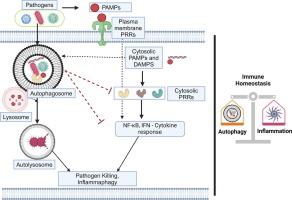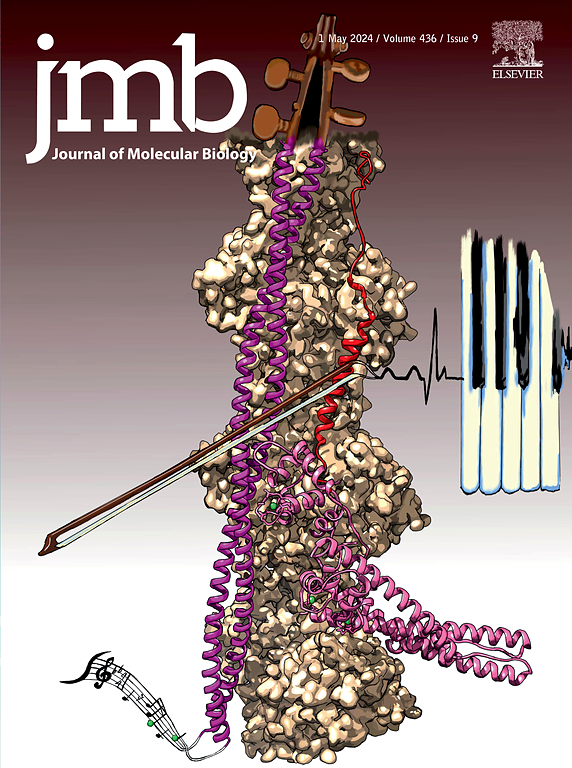Chats and Spats of Autophagy and Innate Immune Systems
IF 4.5
2区 生物学
Q1 BIOCHEMISTRY & MOLECULAR BIOLOGY
引用次数: 0
Abstract
The innate immune system and autophagy are the two fundamental pillars of host defense. Both processes coordinate to maintain cellular homeostasis and protect from multiple threats, ranging from invading pathogens to cellular stresses. Innate immune pathways provide the first line of defense against infections and endogenous threats. They sense microbial structures called pathogen-associated molecular patterns (PAMPs) or danger-associated molecular patterns (DAMPs) released from stressed or damaged cells and mount robust inflammatory responses. Autophagy is a fundamental process that maintains cellular homeostasis by performing multiple functions, including the turnover of damaged organelles and the killing of intracellular pathogens. While initially considered independent pathways, an overwhelming number of studies suggest dynamic crosstalk between these two cell-autonomous systems. Understanding this bidirectional communication will help in developing novel therapeutic strategies targeting infectious diseases, autoimmune disorders, and other immune-related pathologies. This review focuses on the multifaceted relationship between autophagy and innate immunity.

自噬与先天免疫系统的对话与争论。
先天免疫系统和自噬是宿主防御的两大基本支柱。这两个过程协调维持细胞内稳态和保护免受多种威胁,从入侵的病原体到细胞压力。先天免疫途径提供了抵御感染和内源性威胁的第一道防线。它们感知应激或受损细胞释放的微生物结构,称为病原体相关分子模式(PAMPs)或危险相关分子模式(DAMPs),并产生强大的炎症反应。自噬是维持细胞稳态的一个基本过程,它具有多种功能,包括修复受损细胞器和杀死细胞内病原体。虽然最初被认为是独立的途径,但绝大多数研究表明这两个细胞自主系统之间存在动态串扰。了解这种双向沟通将有助于开发针对感染性疾病、自身免疫性疾病和其他免疫相关病理的新治疗策略。本文就自噬与先天免疫的关系作一综述。
本文章由计算机程序翻译,如有差异,请以英文原文为准。
求助全文
约1分钟内获得全文
求助全文
来源期刊

Journal of Molecular Biology
生物-生化与分子生物学
CiteScore
11.30
自引率
1.80%
发文量
412
审稿时长
28 days
期刊介绍:
Journal of Molecular Biology (JMB) provides high quality, comprehensive and broad coverage in all areas of molecular biology. The journal publishes original scientific research papers that provide mechanistic and functional insights and report a significant advance to the field. The journal encourages the submission of multidisciplinary studies that use complementary experimental and computational approaches to address challenging biological questions.
Research areas include but are not limited to: Biomolecular interactions, signaling networks, systems biology; Cell cycle, cell growth, cell differentiation; Cell death, autophagy; Cell signaling and regulation; Chemical biology; Computational biology, in combination with experimental studies; DNA replication, repair, and recombination; Development, regenerative biology, mechanistic and functional studies of stem cells; Epigenetics, chromatin structure and function; Gene expression; Membrane processes, cell surface proteins and cell-cell interactions; Methodological advances, both experimental and theoretical, including databases; Microbiology, virology, and interactions with the host or environment; Microbiota mechanistic and functional studies; Nuclear organization; Post-translational modifications, proteomics; Processing and function of biologically important macromolecules and complexes; Molecular basis of disease; RNA processing, structure and functions of non-coding RNAs, transcription; Sorting, spatiotemporal organization, trafficking; Structural biology; Synthetic biology; Translation, protein folding, chaperones, protein degradation and quality control.
 求助内容:
求助内容: 应助结果提醒方式:
应助结果提醒方式:


